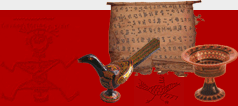|
彝族叙事的时间性
The Temporal Structure of Yi Narrative
刘宗迪 Liu Zongdi
中国社会科学院民族文学研究所
【摘要】时间是知识和叙事的基本前提,对于历史叙述而言,时间的问题尤其至关重要,即使是同一个历史主体(例如彝族)的历史,从不同的时间观出发进行叙述,也将呈现出迥然不同的历史图景。由于时间对于人类生活和知识活动无微不至、无所不在的渗透,人们往往对于自己置身于其中的时间的相对性视而不见,而想当然地认为它是天经地义的、唯一的,康德因此将时间视为人类认知的先验直观形式。只有当历史运动让不同的时间不期而遇时,不同时间之间的巨大反差以及这种反差在历史叙述中引起的种种矛盾、困难和危机才会被人们认识到。现代彝族就处于各种时间样式交错碰撞的情景之中,对于彝族历史、文化、学术的研究,至少下面三种时间是至关重要的,第一,日常的时间:传统的以农耕为主的生活方式以及与之相适应的农时时间仍是彝族民众生活的基调。彝族的民俗生活、宗教生活所遵循的主要是这一种时间样式,这种时间样式决定了彝族民众生活的基本节律,建构了彝族日常世界的基本秩序和彝族思想的宇宙观,对于我们理解彝族文化传统尤其是民俗和宗教传统至关重要。彝族创世神话、传统仪式所呈现的就是这样一种时间。第二,谱系的时间:世代相传的以父子连名制为基础传诵和记忆家支和部族历史的线性时间。父子连名制实际上是一种以家支血统脉络为依据组织和叙述家支历史的纪年方式,这种时间样式迄今为止仍是彝族社会族群区分和认同的主要手段,也是彝族民众记忆本民族历史的主要依据。彝族史诗所呈现的就是这一种时间样式。第三,历史的时间:以朝代更替和帝王纪年为基础的华夏历史年代学。这种时间构成中国历史的主轴和正统,彝族作为华夏世界的边缘成员与这种时间一直保持着一种若即若离的关系,彝族世界只是作为片断和插曲偶尔出现于这个时间中。华夏历代史书中的西南夷志所呈现的出来的就是这样一种时间样式。随着彝族被日益密切地纳入中国政治的整体版图,在当今的彝族叙事中,这三种时间之间的交织、纠葛日益加剧,华夏的历史时间日益成为彝族叙事和历史编纂学的主轴,并极大地改变着其他两种时间,这种趋势将最终改写彝族本族人的历史记忆和族外人对于彝族历史图景的观感。本文试图通过对相关文献的分析,揭示出彝族叙事中这三种时间的共同在场及其相互之间纠缠交织和此消彼长的关系,并希望借此说明时间意识对于彝学研究的重要意义。
关键词:彝族 历史 时间
Abstract
Time is a basic prerequisite for knowledge and narrative,
and when speaking of historical narrative time is of particular
importance, so that history of a single subject (for example
the Yi) seen from two differing perspectives on time can
yield two different historical pictures. Because there is
no bit of human life or knowledge that is not reached by
time, people ordinarily look at the time in which they themselves
live and do not see clearly, and think that it is naturally
given by heaven and earth, the one and only, and for this
reason Kant made human perception of time into the first
style of direct perception in human knowledge. Only when
the movement of history brings events from two different
periods together, will the huge differences between different
time periods and the contradictions, difficulties, and crises
raised in historical narratives by these differences become
recognizable by people. Contemporary Yi people are now in
a situation where different kinds of time are mixing and
colliding. For Yi history, culture, and scholarly research,
at least three kind of time should be seen as important.
First, everyday time: traditional life based in agriculture
and the agricultural timing that fits with it are still
the basic measure of ordinary Yi people’s life. Yi customary
and religious life for the most part fit within this kind
of time, and this kind of time determines the basic divisions
of ordinary Yi people’s life, and structures the basic order
of the everyday world and cosmological beliefs in Yi thought.
For our understanding of Yi culture, in particular customs
and religious life, it is most important. What is embodied
in Yi creation myths and traditional rituals is this kind
of time.
Second, genealogical time The time chain of genealogical
recitation and memory of clan and tribal history through
the generations, passed down on the basis of the father-son
linked name system. The father-son linked name system is
actually a way of organizing and narrating history based
on the vein of patrilineal kinship. This kind of time is
to this day an important method for identifying and delineating
the social structure of Yi society, and is a primary prop
for ordinary Yi people to remember their own history.
Third, historical time Huaxia historical time reckoning
according to the changes of dynasties and the reignes of
emperors. This kind of time structures the revolution and
transmission of Chinese history, and the Yi, living on the
fringes of the Huaxia world, have had a now-distant, now-close
relationship with this kind of historical time; the Yi world
only appears sporadically and marginally in this kind of
time. What can appear in the Southwest Barbarian sections
of successive Huaxia historical works is this kind of time.
With the daily increase in the degree to which the Yi
are now being included in the political structure of China,
in contemporary Yi narratives the weaving together and mutual
entanglement of these three kinds of time also increases
daily, and Huaxia historical time becomes the main vehicle
of Yi historiography, and at the same time brings great
changes to the other two kinds of time; in the end this
trend will certainly rewrite Yi people’s historical memory
and the way that outsiders look at Yi history.
This pape attempts, through the analysis of relevant historical
documents, to delineate the contemporaneous presence of
these three kinds of time in their intertwining and their
relationships of mutual growth and destruction, and also
hopes to use this to explain the important value of time
consciousness to research in Yi studies.
Keywords: Yi Ethnic Minority─History─Time
作者简介:
刘宗迪,民俗学博士。2001年毕业于北京师范大学中文系民俗学专业,获博士学位;2001年至2003年在首都师范大学文学院博士后流动站工作;现为中国社会科学院民族文学研究所副研究员,研究方向为民俗学、神话学、口头传统和文献学。撰述要目:1)《鼓之舞之以尽神:论神和神话的起源》,《民间文学论坛》,1996年第4期;2)《百兽率舞:论原始舞蹈的文化效应》,《文艺研究》,2000年第3期);3)礼仪制度与原始舞蹈》,《民族艺术》,1998年第4期;4)《故事的背后是历史:对两组闽西客家故事的民俗学研究》,《民族文学研究》,2000年第4期;5)《〈山海经?海外经〉与上古历法制度》,《民族艺术》,2002年第2期;6)《文字原是一张皮》,《读书》,2003年第10期;7)《五行说考源》,《哲学研究》,2004年第4期;8)《华夏上古龙崇拜的起源》,《民间文化论坛》,2004年第4期。
About the Author:
Liu Zongdi, received his Ph.D. in Folklore from Beijing
Normal University, now working as an associate researcher
in Folklore, Mythology, Oral Tradition and Chinese Classics
at Institute of Ethnic Literature of China Academy of Social
Sciences (CASS). His Brief Bibliography: “On the Relationship
between Primitive Dances and the Origin of Myths”, Forum
on Folk Literature, Beijing, 1996(4); “The Cultural Effects
of the Primitive Dances”, Literature and Art Studies, Beijing,
2000(3); “On the Relationship between Chinese Ancient Rituals
and Primitive Dances”, Ethnic Arts, 1998(4); “Behind Stories
are Histories”, Studies of Ethnic Literature, 2000(4); “The
Classics of Mountains and Seas (Shanhaijing) and Chinese
Archaic Calendar System” Ethnic Arts,2002(2) ; “On the Relationship
between Oral Tradition and Writing Tradition in Chinese
Axial Period,” Dushu (Readers), 2003(10); “On the Origin
of Five-element (Wuxing) System”, Philosophy Study, 2004(4)
; and “On the Origin of the Dragon Worship and Myth in Ancient
China”, Forum on Folk Culture, 2004(4).
|





